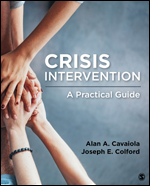Crisis Intervention
A Practical Guide
Alan A. Cavaiola - Monmouth University, USA
Joseph E. Colford - Georgian Court College, New Jersey
Crisis Intervention takes into account various environments and populations across the lifespan to provide students with practical guidelines for managing crises. Drawing on over 25 years of relevant experience, authors Alan A. Cavaiola and Joseph E. Colford cover several different types of crises frequently encountered by professionals in medical, school, work, and community settings. Models for effectively managing these crises are presented along with the authors’ own step-by-step approach, the Listen–Assess–Plan–Commit (LAPC) model, giving students the freedom to select a model that best fits their personal style or a given crisis. Future mental health professionals will gain the knowledge, skills, and confidence to help their clients manage the crises they will encounter in their day-to-day lives.
Available formats
See what’s new to this edition by selecting the Features tab on this page. Should you need additional information or have questions regarding the HEOA information provided for this title, including what is new to this edition, please email sageheoa@sagepub.com. Please include your name, contact information, and the name of the title for which you would like more information. For information on the HEOA, please go to http://ed.gov/policy/highered/leg/hea08/index.html.
For assistance with your order: Please email us at textsales@sagepub.com or connect with your SAGE representative.
SAGE
2455 Teller Road
Thousand Oaks, CA 91320
www.sagepub.com
- Descriptions of crises, assessment considerations, and intervention responses in every chapter provide readers with the tools they need to effectively manage crises.
- Consideration of populations across the lifespan includes children, adolescents, adults, and older adults, as well as individuals, groups, and families.
- Practical guidelines in each chapter provide readers with the dos and don’ts for handling various types of crises.
- Coverage of essential skills for all mental health professionals makes the text helpful for psychiatric social workers, psychiatric nurses, licensed psychologists, and alcohol and drug counselors.
- Content reflective of CACREP standards makes the book ideal for future counselors.
- Real-life case studies and realistic examples provide those new to handling crises with recommendations for appropriately communicating with clients.
- Resources for Chapter Enrichment at the conclusion of chapters include suggested readings and websites.

